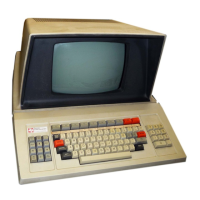.;
!LJ/
945424-9701
------------------------------------------------------------------------------------------------------------------------------------------------------------------------------------~
• CRU Output Data (CRUBITOUT) - CRUBITOUT
is
the high-active serial
output
of
the computer. CRUBITOUT provides the 32 bits
of
information shown in figure
1-9
as
the bits addressed by CRUBIT,12-15. Descriptions
of
the 32 bits shown in figure
1-9
are found in paragraph 1.3.1.6.
• Store Clock (STORECLOCK-) - STORECLOCK-
is
the low-active clock produced by
the computer
that
strobes each bit contained by CRUBITOUT
to
the address specified
by CRUBIT,12-15 at the positive-going edge
of
STORECLK-.
STORECLOCK~
has a
pulse width
of
50 nanoseconds (nominal) and a period
of
250 nanoseconds (nominal).
• CRU Input Data (CRUBITINT) - CRUBITINT
is
the high-active serial
output
from
the
VDT
controller to the computer. CRUBITINT provides the 32 bits
of
information
shown in figure 1-10
as
the bits addressed by CRUBIT,12-15.
• TILINE
1/0
Reset
(TLIORES-)
-
TLIORES-
is
the low-active system reset signal
that resets all VDT controller devices in response to an RSET instruction
or
during
application
of
power
to
the system.
TLIORES-
keeps all connected devices reset until
de power
to
the system
is
up and stable.
• Terminal Interrupts (NKBINT and NKBINT*) - NKBINT and NKBINT* are the
low-active device interrupt signals for the primary (VDT 0) and optional (VDT
1)
controllers, respectively. Each controller produces its interrupt each time a character
code
is
received from the keyboard, then awaits the computer's reply, Keyboard
Acknowledge.
1.3.1.6 Software Interface. Figures
1-9
and 1-10 illustrate the 32
output
and 32
input
bits,
respectively, designated by the system processor with CRUBIT, 12-15. The descriptions
of
the bit
assignments follow.
NOTE
For
the following discussions,
it
is
assumed that CRUBITOUT and
CRUBIT,12-15 have set CRU
output
bit F
16
to
0 prior to
addressing the bit under discussion.
Display Memory Write Data
(CRU
Output
Bits 0-7
16
With
Output
Bit
9
16
= 0). These eight bits
represent a character code
to
be displayed
on
the CRT screen when Write Data Strobe (CRU out-
put bit 8
16
with
output
bit F
16
= 0)
is
issued. The VDT controller latches Display Memory Write
Data and uses it
to
load refresh memory. Characters read from the displayable portion
of
refresh
memory produce the video dot codes that cause the symbols to be displayed on the CRT screen.
On
the United States and European controller versions, bits 0-6
16
represent a seven-bit character,
and bit 7 (most significant bit)
is
used to select character intensity. The Japanese controller has
256 characters (Katakana and alphanumeric), and the dual intensity feature
is
not
active, since
bits 0 through 7 are required
to
describe each character.
1-13
Digital
Systems Division

